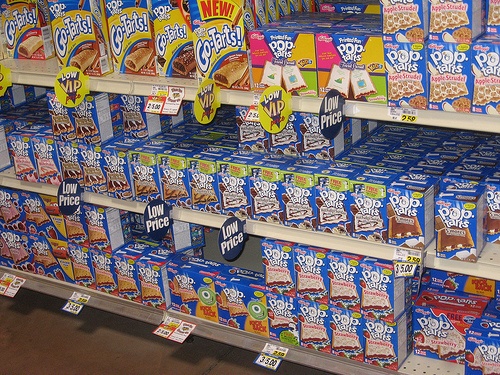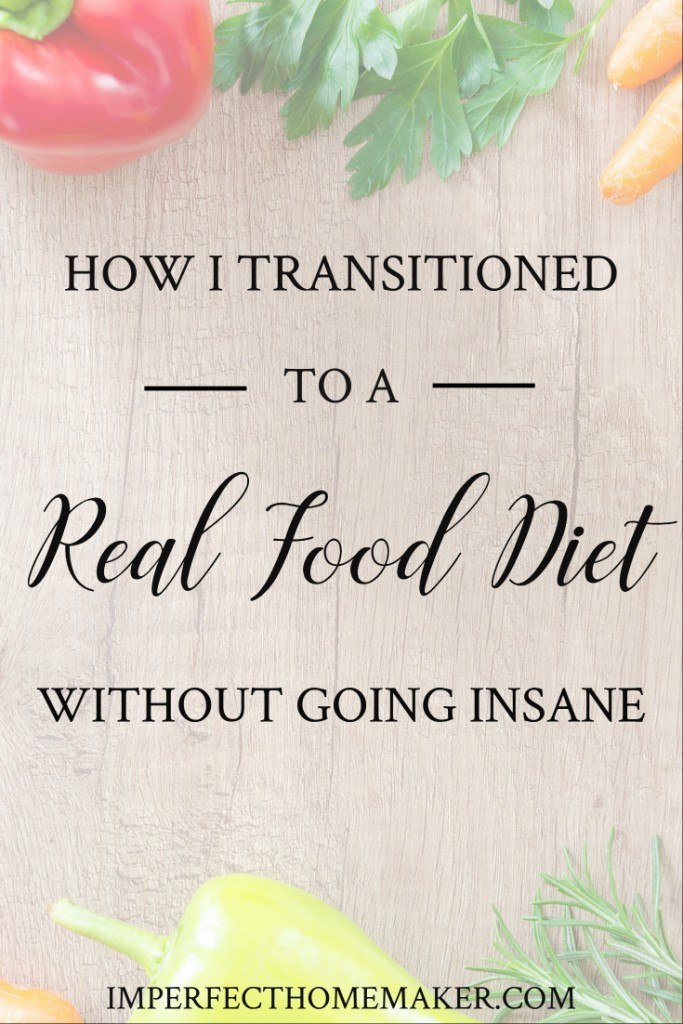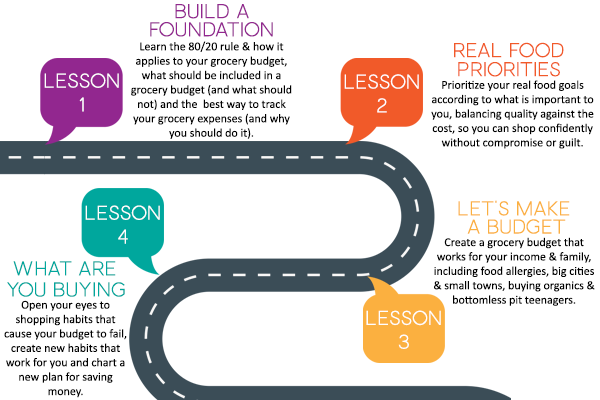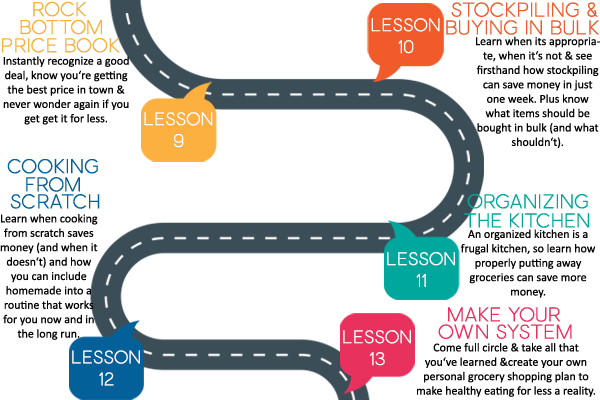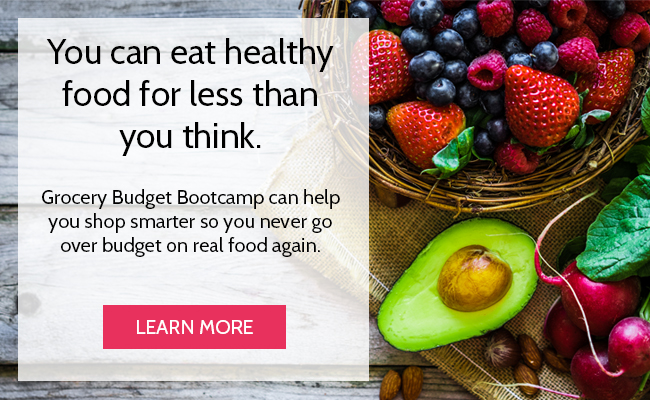How I Transitioned to a Real Food Diet Without Going Insane
I USED TO BUY GROCERIES FOR FREE
I’ll spare you the lengthy details, but a couple years after our marriage, I discovered the world of coupons. I’m not talking about getting a dollar off something we normally bought. I’m talking about checking out with a whole cart full of groceries and having them owe me money at the end. I was good at it, and it was fun.
When I started couponing so heavily, we didn’t have a strict grocery budget. I would just buy whatever was free or close to free with coupons and fill in the gaps with meat and vegetables.
Our pantry was filled to the brim. My husband had to build extra shelves – twice. We had boxes and boxes of cereal, shelves loaded with canned vegetables and soups, boxed potatoes, baking mixes, condiments – you name it and I had it. And I had paid almost nothing for it.
IS “HEALTHY” FOOD REALLY HEALTHY?
I tried to be careful. I tried to buy only the “healthiest” stuff. We ate cereal for breakfast, but I tried to get the kinds with less sugar. We ate granola bars for snacks as opposed to cookies. When I got Hamburger Helper meals for free, I would get them only for the purpose of using the pasta, and I would throw away the packages of chemicalized sauces.
Occasionally the temptation to enjoy convenience crept in, and I would allow myself to bring home cookies, chips, and soda when I got them free. But we still tried to keep the “junk food” to a minimum and only use it as a special treat.
But the fact of the matter is that processed food is…well…processed. It doesn’t matter how many claims on the box say that it’s healthy or all-natural. If it comes in a box or a can, 90% of the time it contains ingredients that were not meant for human consumption. At best, it doesn’t contain any real nutrition. Even if harmful ingredients are not added to the food, the process by which it must be preserved and packaged to withstand a long shelf life at the store renders it nearly void of any nutrients.
Our trend of consuming free-with-coupons food continued for about 3 years. Cooking was easy because I always had a pantry full of food from which to choose. I could open a few boxes and cans, stir them together, and have a meal ready very quickly. But shopping was another story. I grew tired of having to resist the temptation to get the free cookies and chips. I grew tired of not really knowing what my food was made out of, but eating it anyway because it was helping our grocery budget.
WE ATE 40 BOXES OF POP-TARTS
One week I brought home 40 (!) boxes of Pop-tarts, not because we intended to eat them, but because they had paid me to buy them, and I was using the overage to get other things for which there are no coupons like milk, meat, and vegetables.
I should have immediately gotten rid of them, but I stuck them in the pantry to deal with them later. (You know all about my propensity to do that if you’ve been reading here for any length of time!)
Eventually we opened some of them up when we were hungry and needed something in a hurry.
A couple months later I went into the pantry to find that all 40 boxes of the Pop-tarts were GONE! In a couple months time, we had eaten 40 boxes of Pop-tarts. I was disgusted.
TIME FOR A BIG CHANGE
I knew it was time for a big change, and thus began our journey to healthy living. But after shopping this way for so long, I had some big adjustments to make.
First, we had to raise the grocery budget. I would no longer be getting my groceries free or next-to-free. Then I began to research into pastured meat and eggs, organic produce, and eventually even a gluten free diet, once I found out I was gluten sensitive.
Talk about sticker shock!
I knew I wanted to feed my family truly healthy food, but I was lost as to how we could afford to eat that way! After lots of trial and error, I began to figure out which stores to shop at (Take a look at The Ultimate Guide to Buying Healthy Food at Aldi) and other ways to save not only money but also TIME in the kitchen.
I wish I had access to the Grocery Budget Bootcamp back then. Tiffany takes all these things that feel so overwhelming about healthy food and distills them down into bite-sized pieces of information that help you shave hundreds of dollars off your grocery bill. Plus she teaches you how to save hours in the kitchen!
Below are some of the things I learned after tons of hard work and struggling to find the right balance.
(No fair. Grocery Budget Bootcamp hands all of this to you on a silver platter. I had to figure it all out by myself. Where was this course when I needed it??)
1. Prioritize my must-have's and determine where I'm willing to compromise on quality for the sake of the budget. This will look different for everyone, but for me it was buying organic produce that is on the “dirty dozen” list and non-organic for everything else. I also prioritize pastured meat and eggs.
2. Don't focus on what I can't eat but on all the good things I can have and learn to make them taste good. I still crave Oreos and Cheetos and Coke sometimes, but instead of trying to find a direct replacement for those things (translate: organic processed food), I look for something else good that is more healthy. (These homemade peanut butter cups are a great place to start.)
Part of the Grocery Budget Bootcamp roadmap
3. Meal planning is a must! When I had boxes and cans in the pantry all the time, I could throw something together in a snap, even if it was already 5:00. Dump a few cans in here and throw in some boxed goods there, and I'm done. Real food doesn't work that way! I have to know in the morning or even the night before what's on the menu. Beans need to be soaked and cooked for a long period of time, meat needs to be thawed, and many times ingredients need to be made completely from scratch, like salad dressing for example. There is no “winging it” unless I want to be frustrated beyond belief. Grocery Budget Bootcamp teaches you how to time your meal planning so things run smoothly and so that you even know exactly what you're doing with your leftovers.
4. Figure out what to buy in bulk and what to purchase week to week. Buying in bulk is not only a money-saver, but a sanity saver as well because there are just certain ingredients that I need every single day (can we say coconut oil?) I need to know that I always have those ingredients available instead of constantly remembering to buy more every week.
5. Keep a collection of tried and true recipes that work for your family.
One of the frustrating things about being a “real foodie” is that a lot of the food blogs out there are written by actual “foodies.” They love food and they love cooking.
But me? Well, I love food, but I don't love cooking. Or should I say I don't love spending 18,322 hours in the kitchen every day. Trying out new recipes isn't always going to be the best idea because I don't know how long they're going to take to make or how expensive the ingredients will be.
When I find a recipe that meets my criteria (tastes good, uses healthy ingredients, doesn't cost a million dollars and can be made on a mom-friendly timetable, I don't let it out of my sight!) Having a pool of recipes makes menu planning go much more quickly, and I already know the ingredients will help me stay within my budget.
Grocery Budget Bootcamp has so many more ideas for making keeping the cost of real food manageable as well as keeping your sanity intact in the kitchen.
Enrollment is not open at the moment because Tiffany teaches each course live. I highly recommend getting yourself on the waiting list so you'll know as soon as she opens enrollment. Most people taking the course are finding their grocery bill to drop by several hundred dollars each month!
I have total confidence that you can tackle this real food journey, all while keeping your sanity and your budget intact!

